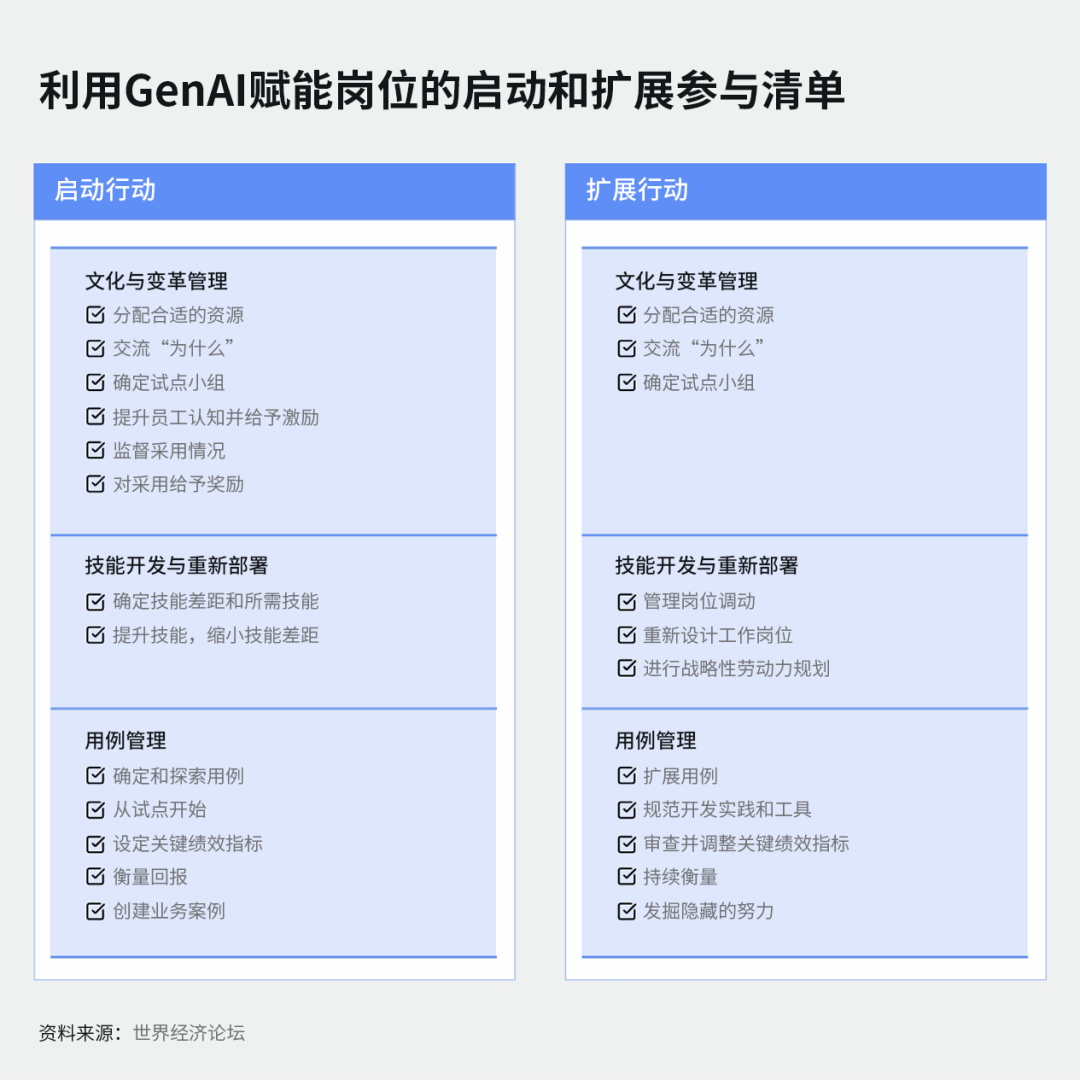Reports indicate that organizations pioneering the adoption of generative AI among their workforce typically exhibit data-driven characteristics.
Image source:Reuters/Dado Ruvic/Illustration/File Photo
David Elliott
Senior Writer for the Forum Agenda
A new report by the World Economic Forum and PwC interviewed more than 20 "early adopter" companies in generative AI.
Some pioneering organizations have identified several emerging trends as they integrate generative AI (GenAI) into their workforce.
This article is adapted from the report "Empowering Jobs and Boosting Workforce Productivity with Generative AI: Scenario Analysis, Case Studies, and an Action Framework."
1. Data-driven organizations are best positioned to leverage the power of GenAI.
The report states that organizations pioneering the adoption of GenAI among their workforce typically exhibit data-driven characteristics. These organizations have a strong, long-standing foundation in establishing robust data quality, infrastructure, governance, and security frameworks. While they may not necessarily be quicker to identify GenAI use cases, once they do, they’re already well-equipped to enable rapid deployment.
2. Organizations are cautiously rolling out GenAIMany early adopters have already moved beyond the initial experimentation phase. In their reports, key lessons learned include: don’t rush into full-scale implementation—instead, test the solution on a small scale before rolling it out more broadly. This approach helps identify potential issues early on, preventing employees from losing interest if the results aren’t as expected.3. A strong sense of risk managementMost organizations in the report are highly cautious about deploying GenAI among their employees. These risks include data breaches, privacy violations, biased outcomes, and other ethical concerns. To safeguard their reputations and avoid conflicts with regulators and authorities, many organizations are adopting a cautious approach, prioritizing experiments and pilot programs conducted in relatively secure internal environments.4. GenAI has boosted productivity, but some organizations aren’t quite sure how to make the most of the time they’ve gained.The report notes that while it remains challenging to assess GenAI's impact on productivity at the macroeconomic level, its benefits are already becoming evident at the organizational level. One company shared that requests that previously took weeks to complete can now be handled in just minutes thanks to automation—demonstrating how efficiency gains can lead to remarkable results in routine, repetitive tasks. The report frequently highlights how this technology empowers employees, with over a quarter of respondents indicating that GenAI enables workers to engage in more enjoyable, creative, and meaningful roles. However, some organizations surveyed have yet to clarify how employees can effectively make use of the time freed up by these advancements.5. Enhancing work quality is another key driver for deploying GenAI.Improving productivity isn’t the only driver for deploying GenAI—respondents also highlighted that enhancing work quality is equally important. When implemented effectively, this technology has the potential to be more accurate and consistent than humans, making fewer mistakes in the process and ultimately boosting both quality and customer satisfaction.6. People don’t always feel satisfied with the outcomes of GenAI technology applications.From concerns about accuracy to potential biases, and even the ethical implications of using GenAI to replace human jobs, employees have many questions about this technology. Typically, IT specialists within companies are among the quickest to embrace GenAI. Meanwhile, departments that rely heavily on administrative tasks are likely to feel the most significant impact, leaving these teams uncertain about their future roles. Training can help demystify the technology—by providing retraining and skill development, it empowers employees to take on new roles while also fostering trust. In the near term, this will be critical: as highlighted by the forum’s “Jobs Initiative,” 44% of workers’ skills could be disrupted by technology within the next five years. The “Jobs Initiative” aims to address these shifts in the labor market, ensuring that everyone has access to meaningful employment opportunities.A checklist for engaging employees when deploying GenAI in the organization.
Image source:World Economic Forum, PwC
7. Implementing GenAI is inseparable from change management.The report emphasizes that when implementing new initiatives, it’s crucial to understand their impact on organizational culture and the mindset shifts required from employees. Effective leadership at the top of the organization is essential. Meanwhile, middle-level managers play a vital role—they are deeply familiar with workflows and processes, giving them the insight needed to identify where GenAI can deliver the greatest value.8. Most organizations are unclear about the proportion of employees using GenAI.In fact, the companies surveyed reported figures ranging from 20% to 80%. Some companies noted that nearly everyone is already using this technology—or at least has the ability to, since their organizations have granted permission to access GenAI tools. The extent to which these tools are made available to employees depends on each company’s risk tolerance; while some respondents allow all staff to use them, others restrict access to specific departments only, or even require employees to apply for a formal license before gaining access.9. Few organizations have developed strategies for the sustainable use of artificial intelligence.Compared to smaller, task-specific AI models, large language models—such as ChatGPT—are energy-intensive AI systems, as each prompt requires significant electricity for computation. While most organizations mentioned in the report acknowledge this issue, few have developed corresponding strategies, and environmental considerations don’t appear to be central to GenAI workforce deployment decisions.10. Removing human involvement is still considered a mistake.Most of the organizations surveyed have established internal committees or councils tasked with developing rules and frameworks, evaluating use cases, and monitoring GenAI for risks, quality, and responsible deployment. Nearly all organizations also reported that they’ve already implemented training programs aimed at fostering the responsible use of these tools. With the exposure of discriminatory algorithm scandals—and the introduction of legislation like the EU’s AI Act—companies have become acutely aware of the critical importance of validation, verification, and human oversight. As one respondent put it: “Perhaps the biggest mistake you can make is excluding humans from the process altogether.”
The above content represents the author's personal views only.This article is translated from the World Economic Forum's Agenda blog; the Chinese version is for reference purposes only.Feel free to share this on WeChat Moments; please leave a comment below the post if you'd like to republish.
Translated by: Sun Qian | Edited by: Wang Can
The World Economic Forum is an independent and neutral platform dedicated to bringing together diverse perspectives to discuss critical global, regional, and industry-specific issues.
Follow us on Weibo, WeChat Video Channels, Douyin, and Xiaohongshu!
"World Economic Forum"






